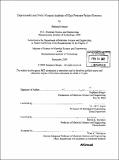Experimental and finite element analysis of high pressure packer elements
Author(s)
Berger, Stephanie, 1981-
DownloadFull printable version (1.762Mb)
Other Contributors
Massachusetts Institute of Technology. Dept. of Materials Science and Engineering.
Advisor
Ali S. Argon and David K. Roylance.
Terms of use
Metadata
Show full item recordAbstract
Packer elements are traditionally rubber seals that can operate under specified downhole conditions and provide a seal for either a short-term, retrievable, or a long-term, permanent, completion. In this case a retrievable 19.7cm (7-3/4") packer element for a high-pressure high-temperature (HPHT) environment was designed and tested. The element created a seal between the mandrel, or tubing, and the casing. At high temperature and pressure rubber needs to be contained so that it will create and maintain an energized seal. In this study only Aflas rubber was tested. Various backup systems were examined; some more traditional designs such as the carbon steel foldback ring were compared to more experimental ideas. Results of theoretical simulations were compared to actual test results in order to gain a greater understanding of element behavior. Experiments were also performed to study the process of element setting, which is difficult to observe due to the high pressures and temperatures required. In a related study alternative materials to rubber such as annealed high-conductivity oxygen-free copper were tested to determine if the properties could be applied for packer element applications. The most successful design was the foldback ring with an anti-extrusion PEEK ring under the gage ring. This design passed a liquid test at 134 MPa (19.5k psi) differential pressure and a gas test at 87.6 MPa (12.7k psi) differential pressure. New designs such as the split ring with mesh and the garter spring with mesh did not pass fixture tests but could be successful with further modifications. FEA was used as an analytical tool to create simulations of the element after a setting force is applied. The modeling was shown to correlate to the actual test results and therefore it would be a good tool to use in future studies.
Description
Thesis (S.M.)--Massachusetts Institute of Technology, Dept. of Materials Science and Engineering, 2004. Includes bibliographical references (leaf 30).
Date issued
2004Department
Massachusetts Institute of Technology. Department of Materials Science and EngineeringPublisher
Massachusetts Institute of Technology
Keywords
Materials Science and Engineering.